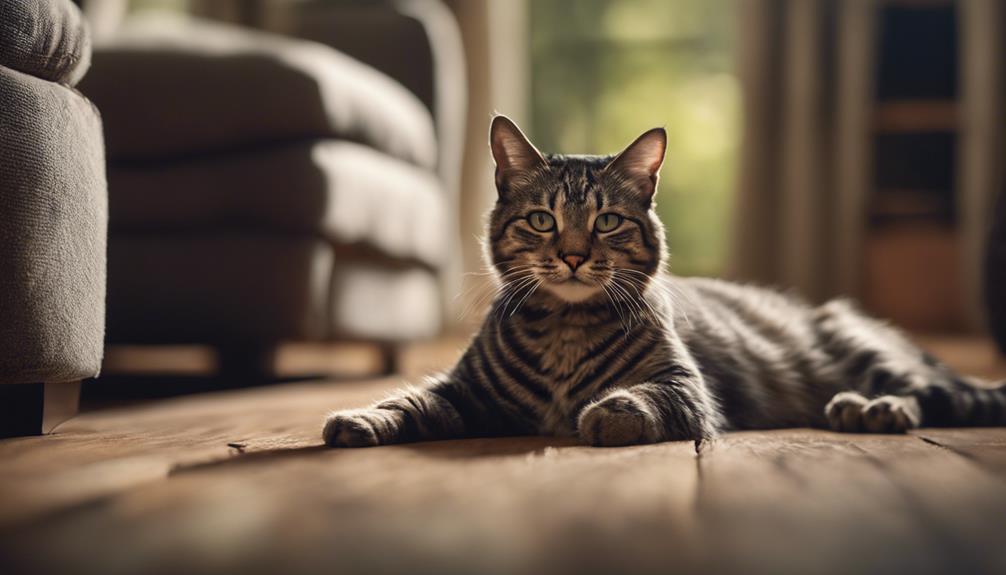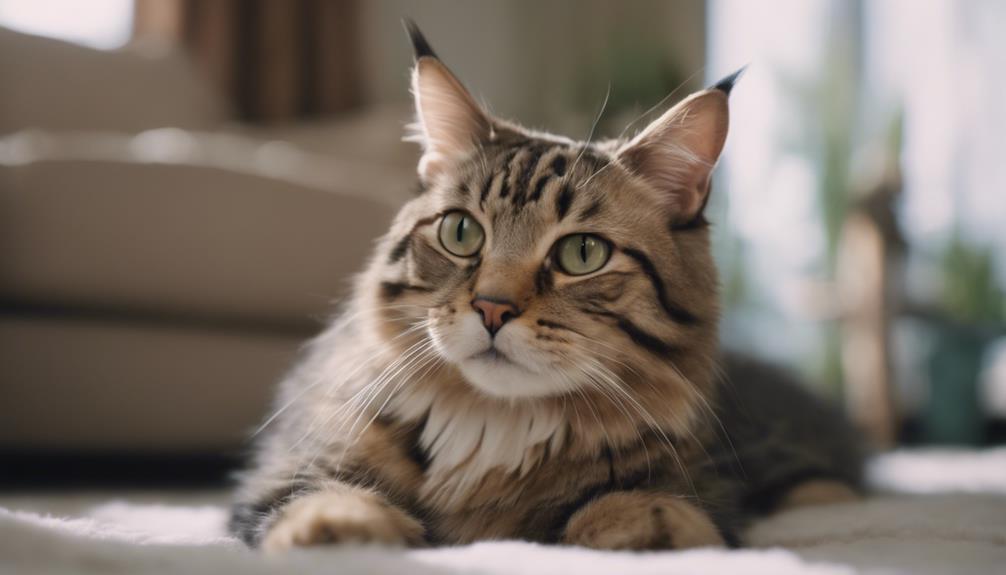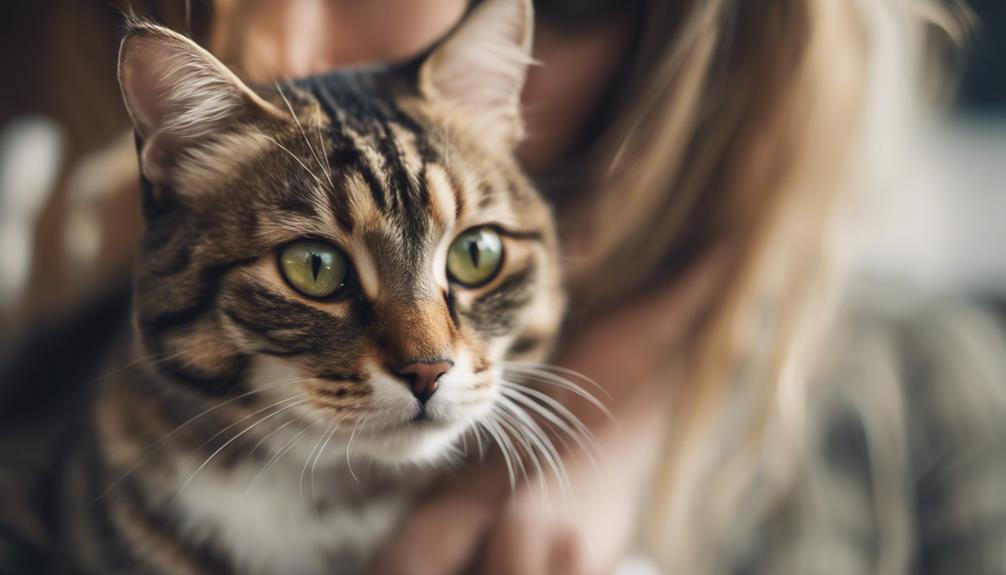The Evolution of the American Bobtail: From Wild to Mild

The American Bobtail's origins can be traced back to the 1960s, when a short-tailed brown tabby male was found wandering the streets of Arizona. Breeders began selectively breeding cats with similar traits, such as a short tail, sturdy body, and friendly demeanor.
This led to the development of the American Bobtail breed, recognized by its unique appearance and affectionate nature. Today, these cats are cherished for their playful personalities and strong bonds with their human companions.
The journey of the American Bobtail from a stray cat to a beloved feline companion showcases the impact of human intervention on the evolution of domesticated animals.
Wild Origins of the American Bobtail
Discovered in the 1960s in North America, the American Bobtail's wild origins sparked initial speculation of a bobcat hybrid lineage. However, genetic testing later refuted this assumption, revealing that the breed's distinctive features are a result of a genetic mutation or the Manx gene.
Found in Arizona by John and Brenda Sanders, the American Bobtail was officially recognized by The International Cat Association (TICA) in 1989. The breed's appearance mirrors that of a wild feline, resembling a mix between a bobcat and a lynx. With its large feet, muscular build, and almond-shaped eyes, the American Bobtail maintains a rugged and wild allure.
Despite its wild appearance, the breed has adapted well to domestic life, becoming a beloved companion for many families. The genetic origins of the American Bobtail give insight into its unique characteristics and its ability to thrive in various environments.
Adaptation to Domestic Life

The American Bobtail has impressively adjusted to domestic life, showcasing behaviors akin to dogs like playing fetch and enjoying walks. Their high intelligence and sociability enable them to form strong connections with their human companions.
Daily human interaction is vital in maintaining their emotional well-being and preventing potential depressive tendencies.
Domestic Behavior Traits
Adapting seamlessly to domestic environments, American Bobtails demonstrate remarkable intelligence and social behavior akin to dogs, enriching the lives of their human companions. These cats exhibit the following domestic behavior traits:
- Interactive Nature: American Bobtails are highly interactive, enjoying activities like playing fetch and responding to human commands.
- Affectionate Bonding: They form strong bonds with their human family members, seeking out affection and companionship.
- Trainable Skills: Due to their high intelligence, American Bobtails are trainable, capable of understanding and following human language and commands.
These characteristics make American Bobtails ideal pets for families seeking a loving, interactive, and trainable feline companion.
Living Environment Adjustment
American Bobtails, known for their remarkable intelligence and social behavior, seamlessly adjust to indoor living environments, thriving in homes equipped with interactive toys and climbing structures. These cats enjoy engaging with their human family members, benefiting greatly from a stimulating environment that includes various enrichment activities. Providing a well-rounded living space for American Bobtails is crucial in preventing boredom and potential behavioral issues. By creating a space filled with interactive toys and climbing structures, owners can ensure the well-being and happiness of their feline companions. Below is a table highlighting key elements for creating an ideal living environment for American Bobtails:
| Key Elements | Description | Importance |
|---|---|---|
| Interactive Toys | Keep the cat mentally and physically active | High |
| Climbing Structures | Provide vertical spaces for exploration | Medium |
| Enrichment Activities | Offer various activities for stimulation | High |
Interaction With Humans
Displaying remarkable adaptability, the American Bobtail has seamlessly integrated into domestic life, showcasing a playful, social, and affectionate nature towards humans.
Key Points:
- Strong Human Bonds: American Bobtails form deep connections with their human families, demonstrating intelligence by understanding commands and human language.
- Dog-like Behaviors: Known for their playful demeanor, these cats exhibit behaviors like playing fetch and going for walks, highlighting their adaptability to human interaction.
- Social Needs: Highly social creatures, American Bobtails require daily interaction to prevent feelings of depression or loneliness, emphasizing their need for human companionship in their domestic environment.
Through their affectionate and interactive nature, American Bobtails have evolved to become loving and engaging companions in the lives of those they share their homes with.
Physical Evolution of the Breed

Throughout the breed's history, the physical evolution of the American Bobtail has been marked by the development of a distinctive bobcat-like appearance. This evolution encompasses key features such as a broad wedge head, medium ears, and a bobtail feature that sets this breed apart.
Over time, various coat colors and patterns have emerged, contributing to the American Bobtail's unique and wild look. Through selective breeding, the breed has refined its broad wedge head and medium ears, enhancing its resemblance to its wild ancestry.
The bobtail feature, which can manifest in different shapes, is a defining trait of the American Bobtail, further accentuating its resemblance to the bobcat. As a result of this physical evolution, the American Bobtail now boasts a sturdy, athletic build that echoes its wild roots, making it both visually striking and functionally adept for its intended purposes.
Behavioral Changes Over Time
Over the course of their domestication, the behavioral traits of the American Bobtail breed have undergone significant transformations. Through selective breeding and socialization, American Bobtails have evolved from their wild roots to become affectionate family pets with distinct temperaments and characteristics:
- Socialization and Temperament: American Bobtails have developed a more social and people-oriented temperament over time. They're known for being devoted, friendly, and intelligent companions, making them ideal for families seeking an affectionate pet.
- Hunting Instincts: Despite transitioning to a more mild temperament, American Bobtails have retained their hunting instincts. This unique combination results in playful, energetic cats that are adaptable to various environments while still showcasing their natural instincts.
- Adaptation to Domestic Life: Through the process of domestication, American Bobtails haven't only changed physically but also behaviorally. They've become more affectionate towards humans and other animals, further solidifying their role as beloved family pets.
Interaction With Humans

American Bobtails exhibit a friendly demeanor towards humans, fostering strong bonds through interactive play and affectionate behaviors. Their intelligence allows them to communicate through body language, responding to human cues and commands effectively.
This ability to understand and engage with humans enhances the quality of interaction and companionship between American Bobtails and their human counterparts.
Friendly Demeanor Towards Humans
Known for their warm and affectionate nature, the American Bobtails exhibit a friendly demeanor towards humans that fosters strong bonds and social interactions. These cats are highly social creatures that enjoy the company of their human family members, often seeking out affection and attention. Their friendly demeanor makes them excellent companions, as they're known to be loyal and loving towards their owners. American Bobtails have a unique ability to understand human language and commands, showcasing their intelligence and adaptability in human environments. Ensuring daily interaction with these cats is crucial for their mental well-being, as they thrive on human companionship and are prone to depression if left alone for extended periods.
3 Fascinating Facts:
- American Bobtails seek out affection and attention from their human family members.
- These cats are loyal and loving companions, forming strong bonds with their owners.
- Daily interaction is essential for the mental well-being of American Bobtails.
Communication Through Body Language
Communication through body language plays a crucial role in the interaction between American Bobtails and humans, facilitating understanding and strengthening the bond between the two. American Bobtails convey their emotional states through various cues such as tail positions, ear movements, and facial expressions.
A twitching tail tip may indicate excitement, while a flicking tail could signal agitation. Ears held forward show curiosity or attention, whereas flattened ears may suggest fear or aggression. A relaxed, slow blink from an American Bobtail signifies trust and affection towards their human companions.
Recognizing and interpreting these body language signals can enhance communication and foster a deeper connection between owners and their American Bobtails, ultimately leading to a more fulfilling relationship.
Role in Modern Society

In modern society, the role of the American Bobtail as a companion animal has evolved to encompass various beneficial functions beyond traditional pet ownership. These cats have become integral to serving others in the following ways:
- Therapy Animals: American Bobtails, with their affectionate and social personalities, excel as therapy animals. Their calming presence and friendly demeanor make them ideal for providing emotional support to individuals in need.
- Educational Programs: American Bobtails are frequently used in educational programs to teach children about responsible pet ownership and cat behavior. Their friendly nature and adaptability make them great ambassadors for fostering positive relationships between humans and animals.
- Agility Training: Some American Bobtails showcase their intelligence and athleticism through agility training and competitions. Their agility and quick learning abilities not only make them excellent competitors but also serve as a source of entertainment and inspiration for spectators.
Future Prospects for the Breed

The ongoing advancement of the American Bobtail breed hinges on a continued dedication to responsible breeding practices and collaboration with veterinary experts to ensure the health and genetic integrity of future generations. Genetic testing plays a crucial role in identifying potential health concerns and maintaining the breed's unique characteristics. By exploring new color variations and patterns through selective breeding, breeders can enhance the diversity within the American Bobtail population. Participation in cat shows and events not only promotes the breed but also provides valuable insights into its distinctive traits and qualities.
Furthermore, research into the genetic origins of the bobtail trait is essential for understanding its inheritance patterns and potential implications for the breed's future development. By transitioning from wild to mild, breeders aim to strike a balance between preserving the bobtail's natural characteristics and ensuring the well-being of each cat. Through a combination of responsible breeding, health-focused practices, and continuous genetic evaluation, the American Bobtail breed is poised for a promising future.
Frequently Asked Questions
What Is the History of the American Bobtail?
The American Bobtail's history is rooted in diverse origins, including a mix of Yodie and a seal-point Siamese. This breed showcases distinct bobcat-like features, robust health, and a friendly temperament. Popular for their unique appearance, they require minimal grooming care.
What Is the Bobtail Mutation in Cats?
The bobtail mutation in cats is a genetic anomaly causing shortened or kinked tails due to altered vertebrae development. This mutation affects various breeds like the American Bobtail. Shared alleles indicate a common genetic origin across breeds.
Are American Bobtails Wild?
American Bobtails, though they bear a wild resemblance, are not wild. Their domestication has led to their mild temperament. This breed's behavior patterns, genetic origins, and taming techniques showcase the impact of human interaction in shaping their friendly nature.
What Are the Unique Features of the American Bobtail?
The American Bobtail boasts a distinct appearance with a short tail, resembling a wild bobcat. This breed is known for its playful personality, dog-like traits, intelligence, and affectionate nature. Bobtail genetics make them a popular and beloved breed.











